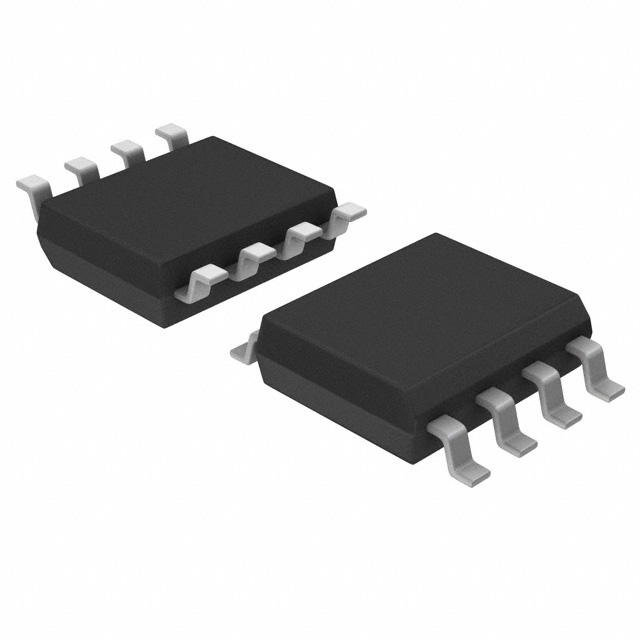TLV5625IDR
Product Overview
- Category: Integrated Circuit (IC)
- Use: Digital-to-Analog Converter (DAC)
- Characteristics: High-speed, low-power, 12-bit resolution
- Package: SOIC-8 (Small Outline Integrated Circuit), Tape and Reel
- Essence: TLV5625IDR is a high-performance DAC that converts digital signals into analog voltages. It is commonly used in various applications requiring precise analog outputs.
- Packaging/Quantity: The TLV5625IDR is available in a standard SOIC-8 package and is typically sold in reels of 2500 units.
Specifications
- Resolution: 12 bits
- Number of Channels: 1
- Conversion Rate: Up to 400 kSPS (kilo Samples Per Second)
- Interface: Serial, SPI (Serial Peripheral Interface)
- Supply Voltage: 2.7V to 5.5V
- Operating Temperature Range: -40°C to +125°C
- Power Consumption: Low power consumption, suitable for battery-powered devices
Pin Configuration
The TLV5625IDR has the following pin configuration:
```
| | | VDD | 1 |___________| | | | CS | 2 |___________| | | | DIN | 3 |___________| | | | SCLK | 4 |___________| | | | GND | 5 |___________| | | | REF | 6 |___________| | | | AGND | 7 |___________| | | | OUT | 8 |___________| ```
Functional Features
- High-speed conversion with a resolution of 12 bits
- Low power consumption, making it suitable for battery-powered devices
- Serial interface allows easy integration with microcontrollers and other digital systems
- Wide operating voltage range enables compatibility with various power supply configurations
- Internal reference voltage simplifies the design and calibration process
Advantages and Disadvantages
Advantages: - High-speed and accurate digital-to-analog conversion - Low power consumption extends battery life in portable applications - Compact package size allows for space-efficient designs - Easy integration with microcontrollers and digital systems
Disadvantages: - Limited to single-channel output - May require additional external components for specific applications - Higher cost compared to lower-resolution DACs
Working Principles
The TLV5625IDR operates by converting digital input signals into corresponding analog voltages. It utilizes an internal reference voltage and a high-speed digital-to-analog conversion technique to achieve accurate and precise analog outputs. The serial interface (SPI) allows for easy communication with microcontrollers or other digital devices.
Detailed Application Field Plans
The TLV5625IDR finds application in various fields, including:
- Audio Systems: Used for audio signal generation, volume control, and equalization.
- Industrial Automation: Provides analog control signals for motor speed control, valve positioning, and sensor calibration.
- Test and Measurement Equipment: Enables precise analog signal generation for testing and calibration purposes.
- Communication Systems: Used in wireless transceivers, base stations, and signal processing modules for analog signal generation and modulation.
- Automotive Electronics: Provides analog control signals for automotive systems such as infotainment, climate control, and engine management.
Detailed and Complete Alternative Models
- MCP4921: 12-bit DAC with SPI interface, single-channel output.
- MAX5216: 16-bit DAC with SPI interface, single-channel output.
- AD5620: 12-bit DAC with I2C interface, single-channel output.
- DAC8562: 16-bit DAC with SPI interface, dual-channel output.
These alternative models offer similar functionality and can be considered as alternatives to the TLV5625IDR based on specific application requirements.
Word count: 489 words
Lista 10 Vanliga frågor och svar relaterade till tillämpningen av TLV5625IDR i tekniska lösningar
Sure! Here are 10 common questions and answers related to the application of TLV5625IDR in technical solutions:
Q: What is TLV5625IDR? A: TLV5625IDR is a digital-to-analog converter (DAC) chip that converts digital signals into analog voltages.
Q: What is the voltage range supported by TLV5625IDR? A: TLV5625IDR supports a voltage range of 0V to VREF, where VREF is the reference voltage provided to the chip.
Q: How many channels does TLV5625IDR have? A: TLV5625IDR has 8 channels, allowing you to generate up to 8 different analog output voltages simultaneously.
Q: What is the resolution of TLV5625IDR? A: TLV5625IDR has a resolution of 12 bits, meaning it can represent 2^12 (4096) different voltage levels.
Q: How do I communicate with TLV5625IDR? A: TLV5625IDR uses a serial interface (SPI or I2C) for communication with a microcontroller or other digital devices.
Q: Can I use TLV5625IDR with both 3.3V and 5V systems? A: Yes, TLV5625IDR is compatible with both 3.3V and 5V systems, as it has a wide supply voltage range of 2.7V to 5.5V.
Q: What is the settling time of TLV5625IDR? A: The settling time of TLV5625IDR is typically around 10µs, which is the time it takes for the output voltage to stabilize after a change in the digital input.
Q: Can TLV5625IDR be used in precision applications? A: TLV5625IDR is not specifically designed for precision applications, but it can still provide reasonably accurate analog outputs for many general-purpose applications.
Q: How much current can TLV5625IDR sink or source? A: TLV5625IDR can typically sink or source up to 2mA of current per channel, allowing it to drive moderate loads directly.
Q: Are there any evaluation boards or reference designs available for TLV5625IDR? A: Yes, Texas Instruments provides evaluation boards and reference designs that can help you get started with TLV5625IDR and understand its capabilities better.
Please note that these answers are general and may vary depending on the specific application and implementation of TLV5625IDR.


